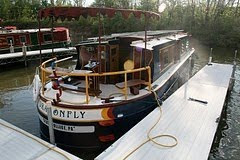I love to read books that connect to the places I’m traveling.
On this trip, both Cap and I read Salt, by Mark Kurlansky. It’s a
sprawling history-of-the-world through the lens of humanity’s quest for salt.
We knew that the Erie Canal made it convenient and cheap to
ship goods around the northeast. We knew that apples, grain, and lumber were important
canal cargos. But we DIDN’T know how important salt was to the development and success of the canal.
A Tax on Salt? Bring It!
Kurlansky writes that the state’s plan for financing canal
construction included levying a tax on salt: 12.5 cents a bushel.
Throughout
history, government taxes on salt have generally led to unrest and revolution. But New York residents actually welcomed this new salt
tax, because they expected the canal to bring prosperity.
Now, consider your annual household consumption of salt—perhaps
a cannister of Morton’s for the table and a five-pound sack for your icy winter
sidewalk? It probably seems unlikely that a salt tax could bring in much revenue.
But remember, these were the days when most food was preserved in salt for
shipping, or to last the winter. Salt beef. Salt pork. Salt fish. Sauerkraut
and pickles. The tax raised plenty of funds.
When construction on the Erie Canal finally started, the
first section to be built was from Utica to the Seneca River—in other words, right through Upstate New York’s
salt producing region. Syracuse, once a swampy lowland, became a major salt port.
Before Salt City, There Was Holley, NY
After we made it all the way west to Buffalo, our return trip took us to a small town
called Holley, east of Albion.
 |
| Dragonfly at the dock in Holley, NY. Seen through the struts of the lift bridge! |
We were intrigued to see, on the list of Holley's village
attractions, a place called “Saltport Eatery.” Why was Holley the Salt Port?
Time for a walk into town!
The restaurant had gone out of business so I did a little online research. Apparently this town got its start in 1814, just a few
years before construction on the canal began. Settlers found a salt lick used
by deer on the banks of a creek. They made salt for a few
years. As the canal opened, the earliest boatmen started referring to the place as “Saltport.”
 |
| No salty french fries awaited us at the former Saltport Eatery, alas. |
Once the canal was booming, though, folks could buy
salt that was better and cheaper, shipped west from Onandaga.
In 1850 the town
was renamed to honor Myron Holley, a state legislator and then canal
commissioner.
That was the end of salt making and Salt Port. But if Holley was no longer a salt-making town, the canal expanded the market for other salt made in New York.
Kurlansky
writes, “The Erie Canal offered a refund on tolls to New York salt producers if
they used the canal to carry salt out of state.”
In trade on the Great Lakes,
salt replaced sand as ballast material. By the 1840s, Syracuse became the
leading supplier of salt in all the Midwest.
 |
| Holley's current claim to fame: a waterfall on its salty creek |
So when you sing the Erie Canal song, remember, those barges weren't just "filled with lumber, coal and hay." They also carried salt.
And the Erie Canal was not just “Clinton’s Ditch.”It was “the ditch that salt built.”






No comments:
Post a Comment